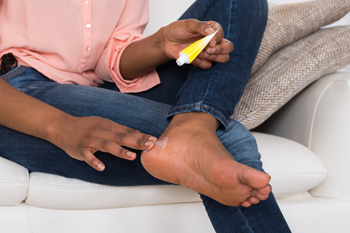Items filtered by date: May 2024
Causes And Treatment Of Cracked Heels

Cracked heels often stem from various factors, including obesity, wearing ill-fitting shoes, prolonged standing, and dry skin. When the skin on your feet lacks moisture and becomes stiff, it is more susceptible to cracking, especially under pressure while standing or walking. Certain conditions, such as diabetes, psoriasis, and flat feet, can further dry out the skin and increase the risk of cracked heels or painful fissures. Preventative measures include moisturizing regularly, avoiding harsh soaps, and opting for closed-heeled shoes with ample cushioning. Wearing cotton socks can also help to reduce friction. Mild relief typically involves moisturizers containing ingredients like urea or hyaluronic acid, which help retain moisture and soften the skin. While mild cases can often be managed at home, it is important to see a podiatrist if heel cracks are associated with a medical condition or if they have become infected. Seeking professional advice ensures a proper diagnosis and treatment, leading to quicker healing and long-term foot health. If cracked and painful heels are causing you discomfort, it is suggested that you schedule an appointment with a podiatrist.
Cracked heels are unsightly and can cause further damage to your shoes and feet. If you have any concerns, contact Braden Jenkins, DPM from The Ridge Foot & Ankle Center. Our doctor can provide the care you need to keep you pain-free and on your feet.
Cracked Heels
Cracked heels appear unappealing and can make it harder for you walk around in sandals. Aside from looking unpleasant, cracked heels can also tear stockings, socks, and wear out your shoes. There are several methods to help restore a cracked heel and prevent further damage.
How Do You Get Them?
Dry skin is the number one culprit in creating cracked heels. Many athletes, walkers, joggers, and even swimmers suffer from cracked heels. Age and skin oil production play a role to getting cracked heels as well.
Promote Healing
Over the counter medicines can help, especially for those that need instant relief or who suffer from chronic dry feet.
Wear Socks – Wearing socks with medicated creams helps lock in moisture.
Moisturizers – Applying both day and night will help alleviate dryness which causes cracking.
Pumice Stones – These exfoliate and remove dead skin, which allows for smoother moisturizer application and better absorption into the skin.
Change in Diet
Eating healthy with a well-balanced diet will give the skin a fresh and radiant look. Your body responds to the kinds of food you ingest. Omega-3 fatty acids and zinc supplements can also revitalize skin tissue.
Most importantly, seek professional help if unsure how to proceed in treating cracked heels. A podiatrist will help you with any questions or information needed.
If you have any questions, please feel free to contact our office located in Idaho Falls, ID . We offer the newest diagnostic and treatment technologies for all your foot care needs.
How Systemic Diseases Can Affect Feet

There are a host of systemic diseases that can contribute to various foot problems, affecting mobility and quality of life. Sciatica, caused by compression of the sciatic nerve, can lead to radiating pain, numbness, and tingling sensations in the feet. Hypothyroidism, characterized by low thyroid hormone levels, may result in cold feet, swelling, and thickened skin. Embolic arterial occlusion, a sudden blockage of an artery by a traveling clot, can cause acute pain, discoloration, and decreased sensation in the feet. Treatment for these conditions varies, depending on the underlying cause and severity. Sciatica may require pain management or surgery in severe cases. Hypothyroidism typically involves hormone replacement therapy and lifestyle modifications. Treatment for embolic arterial occlusion can include blood thinners, thrombolytic therapy, or surgical intervention. If you are experiencing foot problems associated with a systemic disease, it is suggested that you schedule an appointment with a podiatrist for personalized care and treatment to improve foot function.
When dealing with systemic disease of the feet, it is extremely important to check the affected areas routinely so that any additional problems are caught quickly. If you have any concerns about your feet and ankles contact Braden Jenkins, DPM from The Ridge Foot & Ankle Center. Our doctor will assist you with all of your podiatric needs.
Systemic Diseases of the Feet
Systemic diseases affect the whole body, and symptoms usually are displayed in the feet. This condition can make a patient’s ability to walk unbearable. Systemic diseases include gout, diabetes mellitus, neurological disorders, and arthritis.
Gout – is caused by an excess of uric acid in the body. Common symptoms include pain, inflammation, and redness at the metatarsal/phalangeal joint of the base big toe. Gout can be treated by NSAIDs to relieve pain and inflammation, and other drugs that lower the acid levels in the body.
Diabetes mellitus – is an increase in the level of blood sugar that the body cannot counteract with its own insulin. Failure to produce enough insulin is a factor in Diabetes.
Diabetes of the Feet
Diabetic Neuropathy – may lead to damaged nerves and affect the feet through numbness and loss of sensation.
Peripheral Vascular Disease – can restrict the blood flow to the feet, and often times lead to amputation of the feet.
If you have any questions please feel free to contact our office located in Idaho Falls, ID . We offer the newest diagnostic and treatment technologies for all your foot and ankle needs.
What Is a Diabetic Foot Ulcer?
 Diabetic foot ulcers are a common and serious complication of diabetes. Ulcers are open sores or wounds that typically appear on the bottom of the foot. They often start as small blisters or cuts but can evolve into deeper wounds due to poor circulation and nerve damage in the feet. This nerve damage, also known as neuropathy, is common in people with diabetes. Neuropathy diminishes the ability to feel pain, allowing injuries to go unnoticed and untreated. Poor blood circulation also reduces the ability of the body to heal, making even minor wounds potentially serious. A diabetic foot ulcer looks like a red crater in the skin, which may weep fluid. The area around the ulcer may be swollen, red, and warm to the touch. Prompt treatment is important to prevent infection and further serious complications, such as gangrene or amputation. Regular foot inspections, maintaining blood sugar levels, and appropriate footwear are key preventative measures for those with diabetes to minimize the risk of developing ulcers. If you have foot ulcers due to diabetes, it is suggested that you consult a podiatrist for regular check-ups.
Diabetic foot ulcers are a common and serious complication of diabetes. Ulcers are open sores or wounds that typically appear on the bottom of the foot. They often start as small blisters or cuts but can evolve into deeper wounds due to poor circulation and nerve damage in the feet. This nerve damage, also known as neuropathy, is common in people with diabetes. Neuropathy diminishes the ability to feel pain, allowing injuries to go unnoticed and untreated. Poor blood circulation also reduces the ability of the body to heal, making even minor wounds potentially serious. A diabetic foot ulcer looks like a red crater in the skin, which may weep fluid. The area around the ulcer may be swollen, red, and warm to the touch. Prompt treatment is important to prevent infection and further serious complications, such as gangrene or amputation. Regular foot inspections, maintaining blood sugar levels, and appropriate footwear are key preventative measures for those with diabetes to minimize the risk of developing ulcers. If you have foot ulcers due to diabetes, it is suggested that you consult a podiatrist for regular check-ups.
Diabetic foot care is important in preventing foot ailments such as ulcers. If you are suffering from diabetes or have any other concerns about your feet, contact Braden Jenkins, DPM from The Ridge Foot & Ankle Center. Our doctor can provide the care you need to keep you pain-free and on your feet.
Diabetic Foot Care
Diabetes affects millions of people every year. The condition can damage blood vessels in many parts of the body, especially the feet. Because of this, taking care of your feet is essential if you have diabetes, and having a podiatrist help monitor your foot health is highly recommended.
The Importance of Caring for Your Feet
- Routinely inspect your feet for bruises or sores.
- Wear socks that fit your feet comfortably.
- Wear comfortable shoes that provide adequate support.
Patients with diabetes should have their doctor monitor their blood levels, as blood sugar levels play such a huge role in diabetic care. Monitoring these levels on a regular basis is highly advised.
It is always best to inform your healthcare professional of any concerns you may have regarding your feet, especially for diabetic patients. Early treatment and routine foot examinations are keys to maintaining proper health, especially because severe complications can arise if proper treatment is not applied.
If you have any questions please feel free to contact our office located in Idaho Falls, ID . We offer the newest diagnostic and treatment technologies for all your foot and ankle needs.
Common Symptoms of an Achilles Tendon Injury

The Achilles tendon, the largest tendon in the body, plays an essential role in facilitating movement and stability in the lower extremities. When injured, this vital structure can cause significant discomfort and impairment. One common symptom of an Achilles tendon injury is pain and stiffness along the back of the heel or calf, particularly during physical activity or when stretching the foot. Swelling and tenderness may also be present in the affected area, accompanied by a sensation of warmth or redness. In some cases, individuals may experience a noticeable decrease in strength or flexibility in the ankle joint. Achilles tendon injuries can range from mild strains to more severe conditions, such as tendonitis or ruptures, which may require medical intervention for proper management and healing. Recognizing these symptoms is vital for a prompt diagnosis and treatment. If you have endured this type of injury, it is strongly suggested that you confer with a podiatrist who can begin the appropriate treatment method.
Achilles tendon injuries need immediate attention to avoid future complications. If you have any concerns, contact Braden Jenkins, DPM of The Ridge Foot & Ankle Center. Our doctor can provide the care you need to keep you pain-free and on your feet.
What Is the Achilles Tendon?
The Achilles tendon is a tendon that connects the lower leg muscles and calf to the heel of the foot. It is the strongest tendon in the human body and is essential for making movement possible. Because this tendon is such an integral part of the body, any injuries to it can create immense difficulties and should immediately be presented to a doctor.
What Are the Symptoms of an Achilles Tendon Injury?
There are various types of injuries that can affect the Achilles tendon. The two most common injuries are Achilles tendinitis and ruptures of the tendon.
Achilles Tendinitis Symptoms
- Inflammation
- Dull to severe pain
- Increased blood flow to the tendon
- Thickening of the tendon
Rupture Symptoms
- Extreme pain and swelling in the foot
- Total immobility
Treatment and Prevention
Achilles tendon injuries are diagnosed by a thorough physical evaluation, which can include an MRI. Treatment involves rest, physical therapy, and in some cases, surgery. However, various preventative measures can be taken to avoid these injuries, such as:
- Thorough stretching of the tendon before and after exercise
- Strengthening exercises like calf raises, squats, leg curls, leg extensions, leg raises, lunges, and leg presses
If you have any questions please feel free to contact our office located in Idaho Falls, ID . We offer the newest diagnostic tools and technology to treat your foot and ankle needs.

